Ultra-Generalized Continuous Class F Power Amplifier with Finite Third-Harmonic Load Impedance
Abstract
:1. Introduction
2. Analysis of the Proposed UCCF Mode
2.1. Gate Input Voltage Waveform of Proposed UCCF Mode
2.2. Drain Current Waveform of the Proposed UCCF Mode
2.3. Load Impedance Design Space of the Proposed UCCF Mode
2.4. Performance of Proposed UCCF Mode
3. Fabrication and Measurement Result of the Proposed UCCF Mode PA
4. Conclusions
Author Contributions
Funding
Institutional Review Board Statement
Informed Consent Statement
Data Availability Statement
Conflicts of Interest
References
- Li, X.; Helaoui, M.; Ghannouchi, F.M.; Zhao, Y.; Liu, C.; Chen, W.; Sharawi, M.S. A class-X power amplifier with finite number of harmonics. IEEE Trans. Microw. Theory Tech. 2022, 70, 3897–3909. [Google Scholar] [CrossRef]
- Poluri, N.; Souza, M.M.D. High-efficiency modes contiguous with class B/J and continuous class F−1 amplifiers. IEEE Microw. Wireless Compon. Lett. 2019, 29, 137–139. [Google Scholar] [CrossRef]
- Wright, P.; Lees, J.; Benedikt, J.; Tasker, P.J.; Cripps, S.C. A methodology for realizing high efficiency class-J in a linear and broadband PA. IEEE Trans. Microw. Theory Tech. 2009, 57, 3196–3204. [Google Scholar] [CrossRef]
- Rezaei, S.; Belostotski, L.; Helaoui, M.; Ghannouchi, F.M. Harmonically tuned continuous class-C operation mode for power amplifier applications. IEEE Trans. Microw. Theory Tech. 2014, 62, 3017–3027. [Google Scholar] [CrossRef]
- Carrubba, V.; Clarke, A.L.; Akmal, M.; Yusoff, Z.; Lees, J.; Benedikt, J.; Cripps, S.C.; Tasker, P.J. Exploring the design space for broadband PAs using the novel continuous inverse class-F mode. In Proceedings of the 2011 41st European Microwave Conference, Manchester, UK, 10–13 October 2011; pp. 10–13. [Google Scholar]
- Alizadeh, A.; Medi, A. Investigation of a class-J mode power amplifier in presence of a second-harmonic voltage at the gate node of the transistor. IEEE Trans. Microw. Theory Tech. 2017, 65, 3024–3033. [Google Scholar] [CrossRef]
- Huang, C.; He, S.; Shi, W.; Song, B. Design of broadband high efficiency power amplifiers based on the hybrid continuous modes with phase shift parameter. IEEE Microw. Wireless Compon. Lett. 2018, 28, 159–161. [Google Scholar] [CrossRef]
- Abbasian, S.; Johnson, T. Power-Efficiency characteristics of class-F and inverse class-F synchronous rectifiers. IEEE Trans. Microw. Theory Tech. 2016, 64, 4740–4751. [Google Scholar] [CrossRef]
- Kim, J.H.; Lee, S.J.; Park, B.H.; Jang, S.H.; Jung, J.H.; Park, C.S. Analysis of high-efficiency power amplifier using second harmonic manipulation: Inverse class-F/J amplifiers. IEEE Trans. Microw. Theory Tech. 2011, 59, 2024–2036. [Google Scholar] [CrossRef]
- Krauss, H.L.; Bostain, C.W.; Raab, F.H. Solid State Radio Engineering; Wiley: New York, NY, USA, 1980. [Google Scholar]
- Cripps, S.C. RF Power Amplifier for Wireless Communication, 2nd ed.; Artech House: Norwood, MA, USA, 2006. [Google Scholar]
- Carrubba, V.; Clarke, A.L.; Akmal, M.; Lees, J.; Benedikt, J.; Tasker, P.J.; Cripps, S.C. The continuous class-F mode power amplifier. In Proceedings of the 5th European Microwave Integrated Circuits Conference, Paris, France, 27–28 September 2010; pp. 432–435. [Google Scholar]
- Gao, S. High efficiency class-F RF/microwave power amplifiers. IEEE Microw. Mag. 2006, 7, 40–48. [Google Scholar] [CrossRef]
- Chen, K.; Peroulis, D. A 3.1-GHz class-F power amplifier with 82% power-added-efficiency. IEEE Microw. Wireless Compon. Lett. 2013, 23, 436–438. [Google Scholar] [CrossRef]
- Raab, F.H. Maximum efficiency and output of class-F power amplifiers. IEEE Trans. Microw. Theory Tech. 2001, 49, 1162–1166. [Google Scholar] [CrossRef]
- Grebennikov, A.; Raab, F.H. History of Class-F and inverse Class-F techniques: Developments in high–efficiency power amplification from the 1910s to the 1980s. IEEE Microw. Mag. 2018, 19, 99–115. [Google Scholar] [CrossRef]
- Woo, Y.Y.; Yang, Y.; Kim, B. Analysis and experiments for high-efficiency class-F and inverse class-F power amplifiers. IEEE Trans. Microwave Theory Tech. 2006, 54, 1969–1974. [Google Scholar]
- Raab, F.H. Class-E, class-C, and class-F power amplifiers based upon a finite number of harmonics. IEEE Trans. Microw. Theory Tech. 2001, 49, 1462–1468. [Google Scholar] [CrossRef]
- Dhar, S.K.; Sharma, T.; Zhu, N.; Darraji, R.; Mclaren, R.; Holmes, D.G.; Mallette, V.; Ghannouchi, F.M. Input-Harmonic-Controlled broadband continuous class-F power amplifiers for sub-6-GHz 5G applications. IEEE Trans. Microw. Theory Tech. 2020, 68, 3120–3133. [Google Scholar] [CrossRef]
- Zheng, S.; Liu, Z.; Zhang, X.; Zhou, X.; Chan, W. Design of ultra- wideband high-efficiency extended continuous class-F power amplifier. IEEE Trans. Ind. Electron. 2018, 65, 4661–4669. [Google Scholar] [CrossRef]
- Chen, K.; Peroulis, D. Design of broadband highly efficient harmonic-tuned power amplifier using in-band continuous class-F−1/F mode transferring. IEEE Trans. Microw. Theory Tech. 2012, 60, 4107–4116. [Google Scholar] [CrossRef]
- Chen, J.; He, S.; You, F.; Tong, R.; Peng, R. Design of broadband high efficiency power amplifiers based on a series of continuous modes. IEEE Microw. Compon. Lett. 2014, 24, 631–633. [Google Scholar] [CrossRef]
- Tuffy, N.; Guan, L.; Zhu, A.; Brazil, T.J. A simplified broadband design methodology for linearized high-efficiency continuous class–F power amplifiers. IEEE Trans. Microw. Theory Tech. 2012, 60, 1952–1963. [Google Scholar] [CrossRef]
- Miura, O.; Ishikawa, R.; Honjo, K. Parasitic-element compensation based on factorization method for microwave inverse class-F/class-F amplifiers. IEEE Microw. Wireless Compon. Lett. 2012, 22, 521–523. [Google Scholar] [CrossRef]
- Kuroda, K.; Ishikawa, R.; Honjo, K. Parasitic compensation design technique for a C-band GaN HEMT class-F amplifier. IEEE Trans. Microw. Theory Tech. 2010, 58, 2741–2750. [Google Scholar] [CrossRef]
- Dong, Y.; Mao, L.; Xie, S. Extended continuous inverse class-F power amplifiers with class-AB bias conditions. IEEE Microw. Wireless Compon. Lett. 2017, 27, 368–370. [Google Scholar] [CrossRef]
- Moon, J.; Jee, S.; Kim, J.; Kim, J.; Kim, B. Behaviors of Class-F and Class-F−1 Amplifiers. IEEE Trans. Microw. Theory Tech. 2012, 60, 1937–1951. [Google Scholar] [CrossRef]
- Sharma, T.; Darraji, R.; Ghannouchi, F.; Dawar, N. Generalized continuous class-F harmonic tuned power amplifiers. IEEE Microw. Wireless Compon. Lett. 2016, 26, 213–215. [Google Scholar] [CrossRef]
- Kim, J.H.; Jo, G.D.; Oh, J.H.; Kim, Y.H.; Lee, K.C.; Jung, J.H. Modeling and design methodology of high-efficiency class-F and class-F−1 power amplifiers. IEEE Trans. Microw. Theory Tech. 2011, 59, 153–165. [Google Scholar] [CrossRef]
- Han, K.; Geng, L. Enhancing efficiency and linearity of continuous class-F3 power amplifier with peak-clipped current waveform. IEEE Trans. Microw. Theory Tech. 2022, 70, 1423–1431. [Google Scholar] [CrossRef]
- Tasker, P.; Benedikt, J. Waveform inspired models and the harmonic balance emulator. IEEE Microw. Mag. 2011, 12, 38–54. [Google Scholar] [CrossRef]
- Carrubba, V.; Lees, I.; Benedikt, J.; Tasker, P.J.; Cripps, S.C. A Novel Highly Efficient Broadband Continuous Class-F RFPADelivering 74% Average Efficiency for an Octave Bandwidth. In Proceedings of the 2011 IEEE MTT-S International Microwave Symposium, Baltimore, MD, USA, 5–10 June 2011. [Google Scholar]
- Li, X.; Helaoui, M.; Ghannouchi, F. Optimal fundamental load modulation for harmonically tuned switch mode power amplifier. In Proceedings of the 2016 IEEE MTT-S International Microwave Symposium (IMS), San Francisco, CA, USA, 22–27 May 2016; pp. 1–4. [Google Scholar]
- Chu, C.; Tamrakar, V.; Dhar, S.K.; Sharma, T.; Mukherjee, J.; Zhu, A. High-efficiency class-iF−1 power amplifier with enhanced linearity. IEEE Trans. Microw. Theory Tech. 2023, 71, 1977–1989. [Google Scholar] [CrossRef]
- Li, S.; Wu, Y.; Yang, Y.; Chen, X.; Wang, W.; Chen, Z. Bandpass filtering power amplifier with wide stopband and high out-of-band rejection. IEEE Trans. Circuits Syst. II Exp. Briefs 2023, 70, 969–973. [Google Scholar] [CrossRef]
- Haider, M.F.; You, F.; Qi, T.; Li, C.; Ahmad, S. Co-Design of second harmonic-tuned power amplifier and a parallel-coupled stub loaded resonator. IEEE Trans. Circuits Syst. II Exp. Briefs 2020, 67, 3013–3017. [Google Scholar] [CrossRef]
- Yang, M.; Xia, J.; Guo, Y.; Zhu, A. Highly efficient broadband continuous inverse class-F power amplifier design using modified elliptic low-pass filtering matching network. IEEE Trans. Microw. Theory Tech. 2016, 64, 1515–1525. [Google Scholar] [CrossRef]
- Eskandari, S.; Zhao, Y.; Helaoui, M.; Ghannouchi, F.M.; Kouki, A.B. Continuous-mode inverse class-GF power amplifier with second-harmonic impedance optimization at device input. IEEE Trans. Microw. Theory Tech. 2021, 69, 2506–2518. [Google Scholar] [CrossRef]
- Su, Z.; Yu, C.; Tang, B.; Liu, Y. Bandpass filtering power amplifier with extended band and high efficiency. IEEE Microw. Wireless Compon. Lett. 2020, 30, 181–184. [Google Scholar] [CrossRef]
- Guo, Q.-Y.; Zhang, X.Y.; Xu, J.-X.; Li, Y.C.; Xue, Q. Bandpass class-F power amplifier based on multifunction hybrid cavity–microstrip filter. IEEE Trans. Circuits Syst. II Exp. Briefs 2017, 64, 742–746. [Google Scholar] [CrossRef]

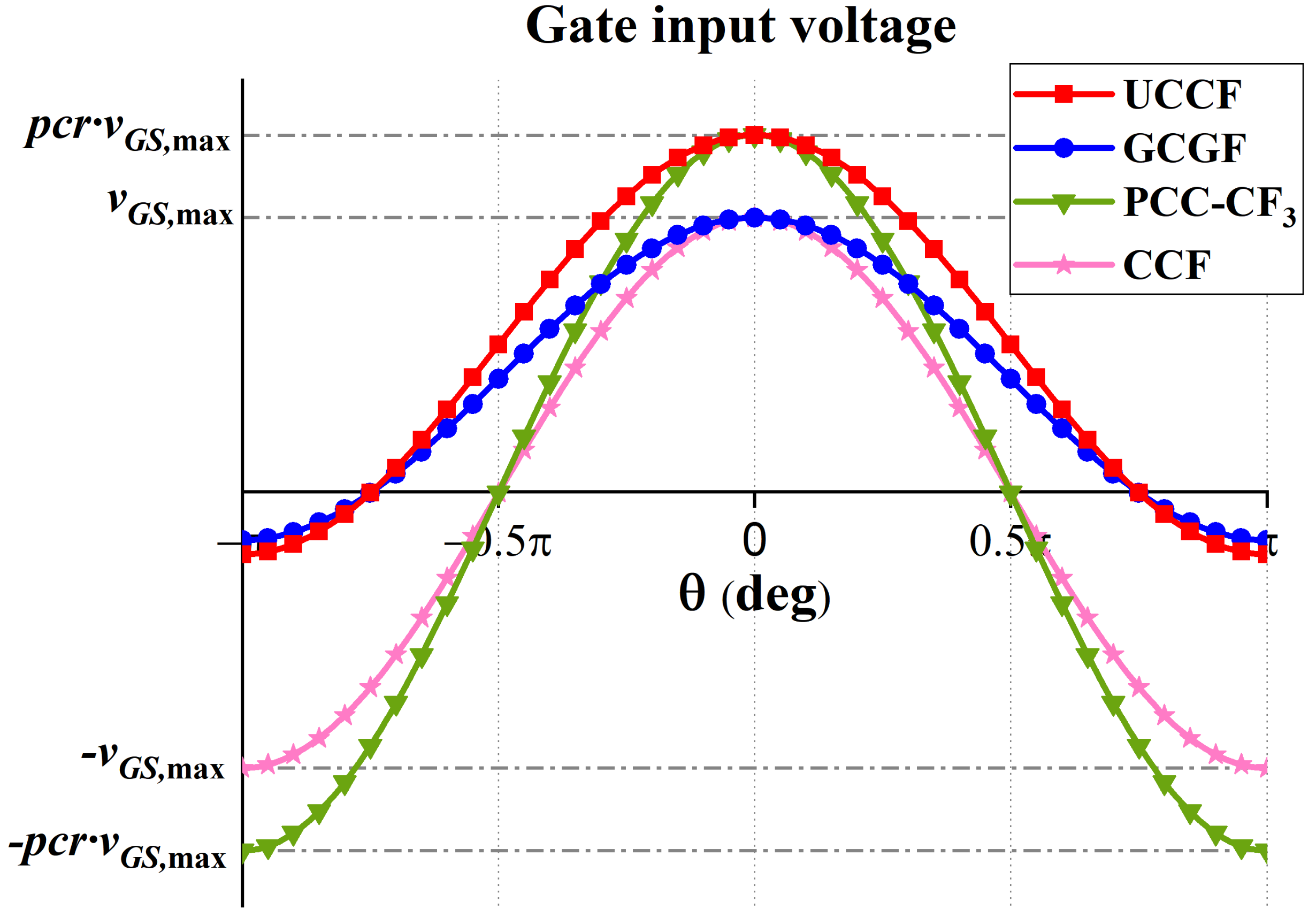
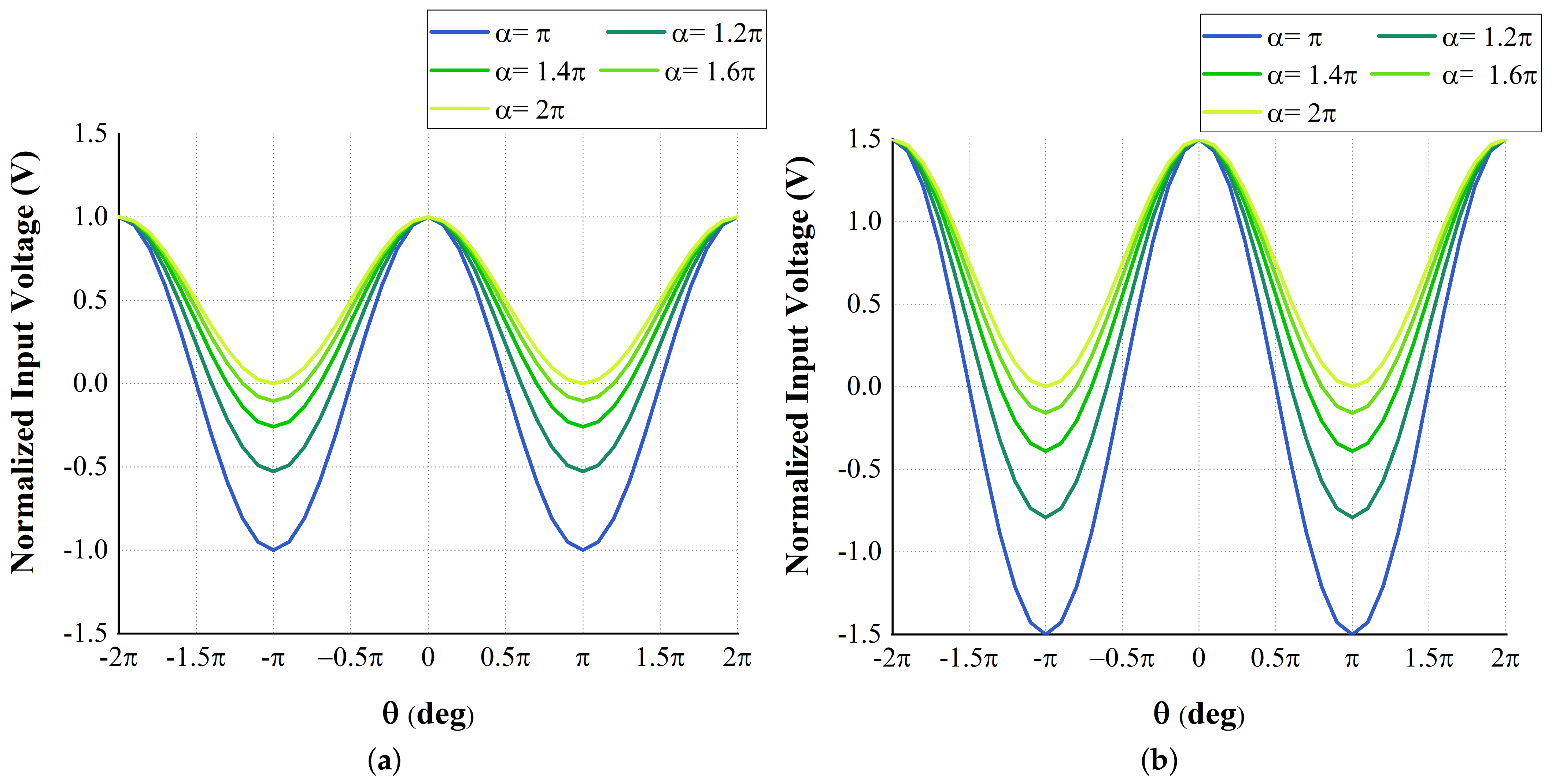
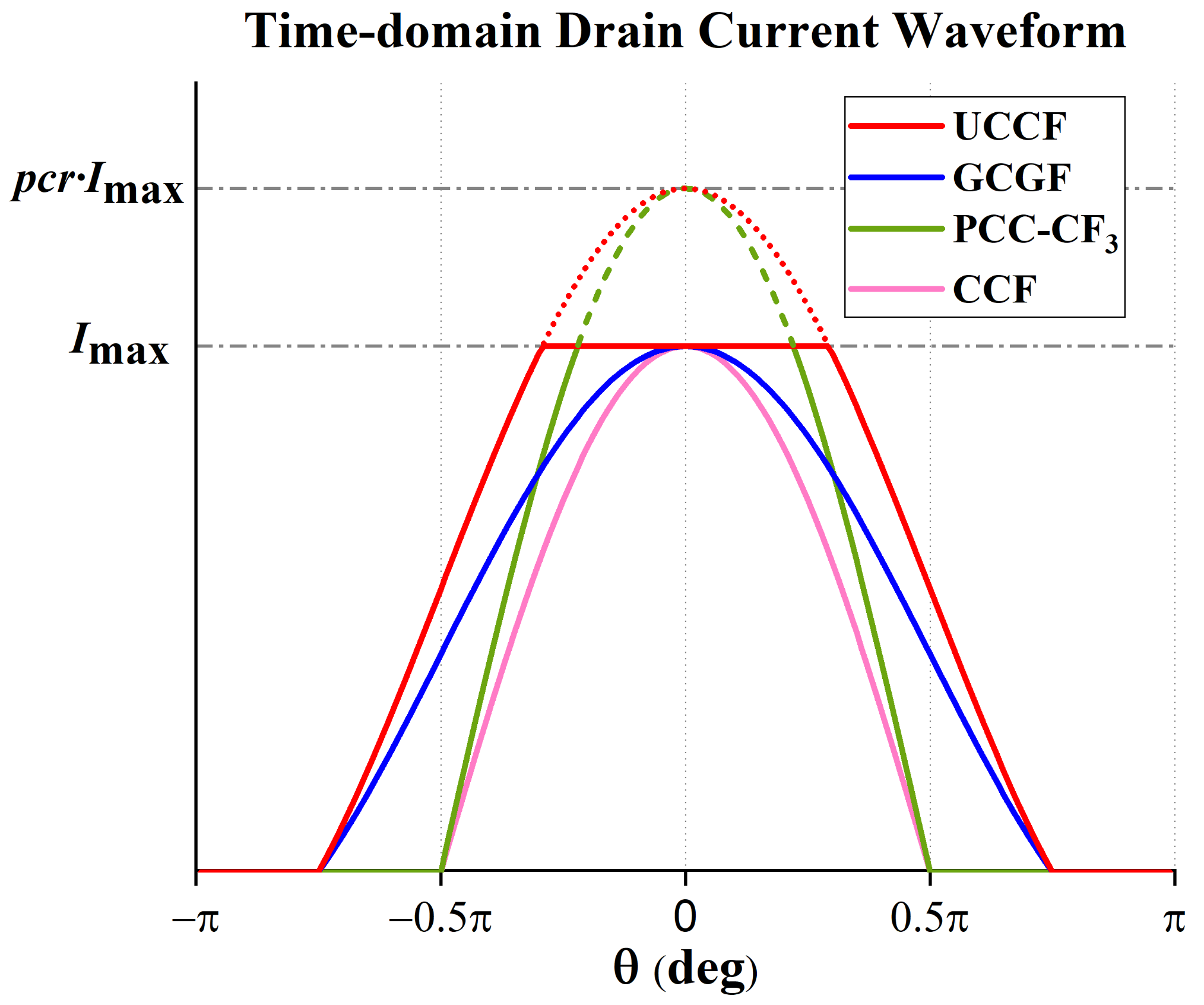
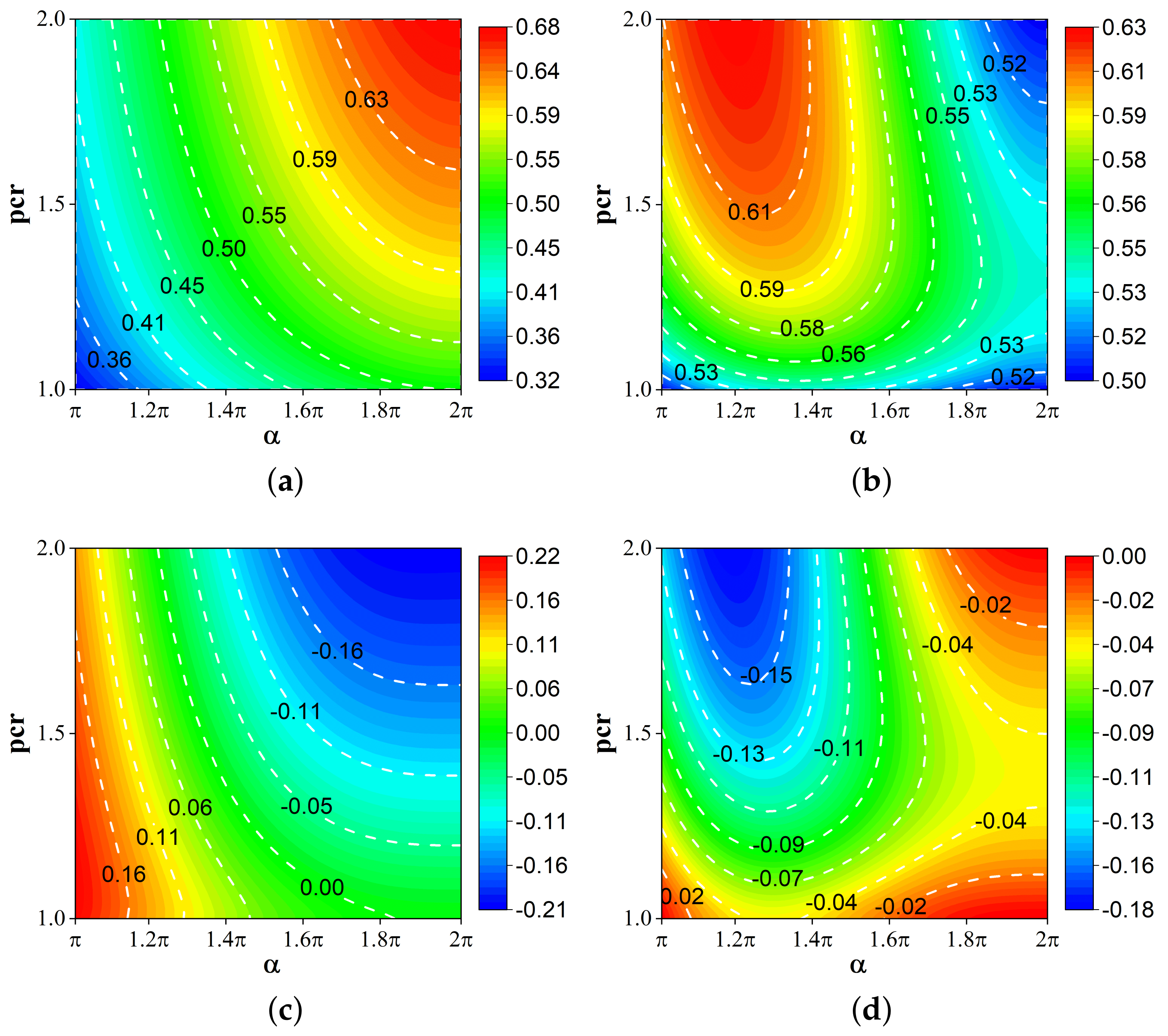

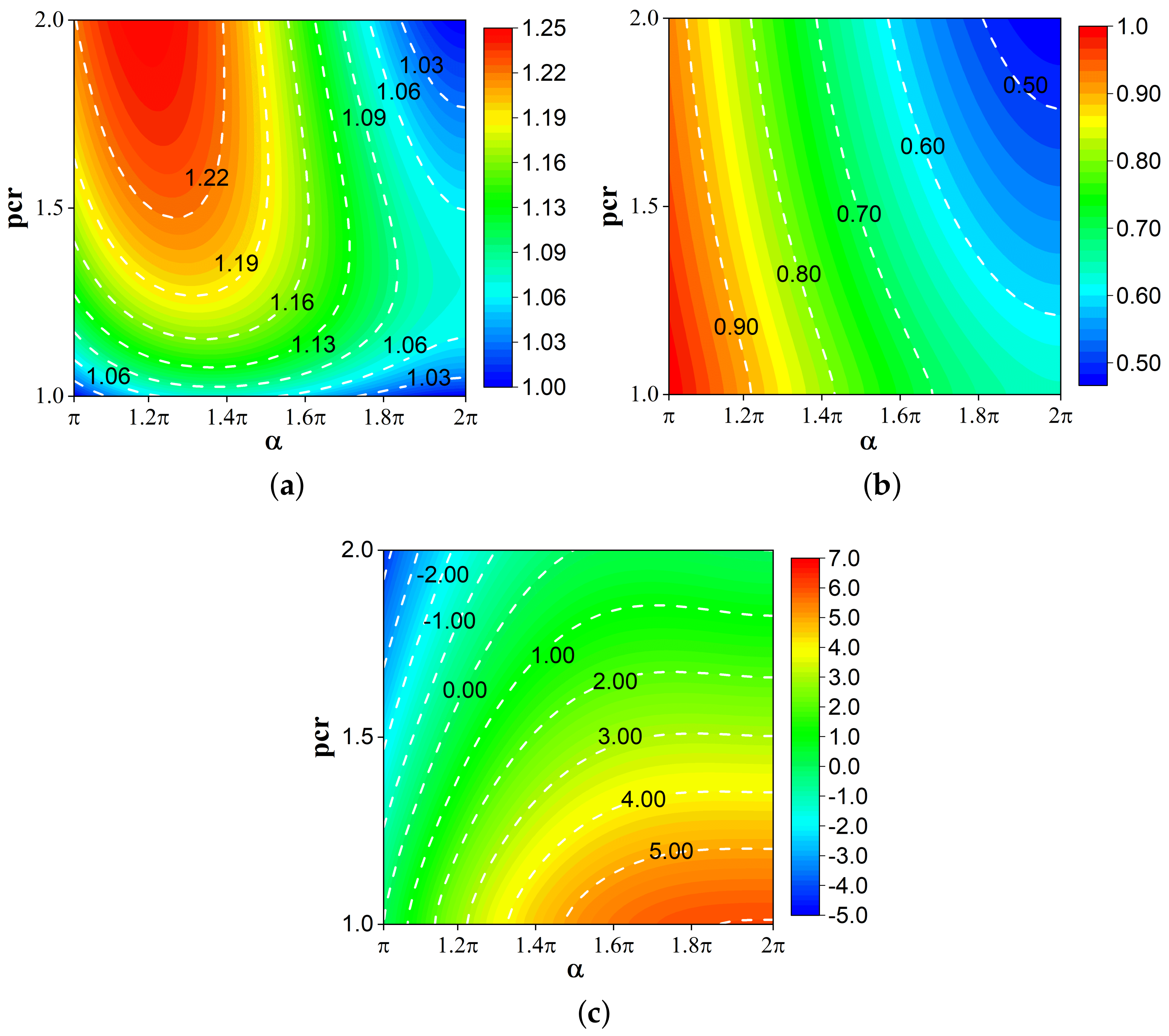


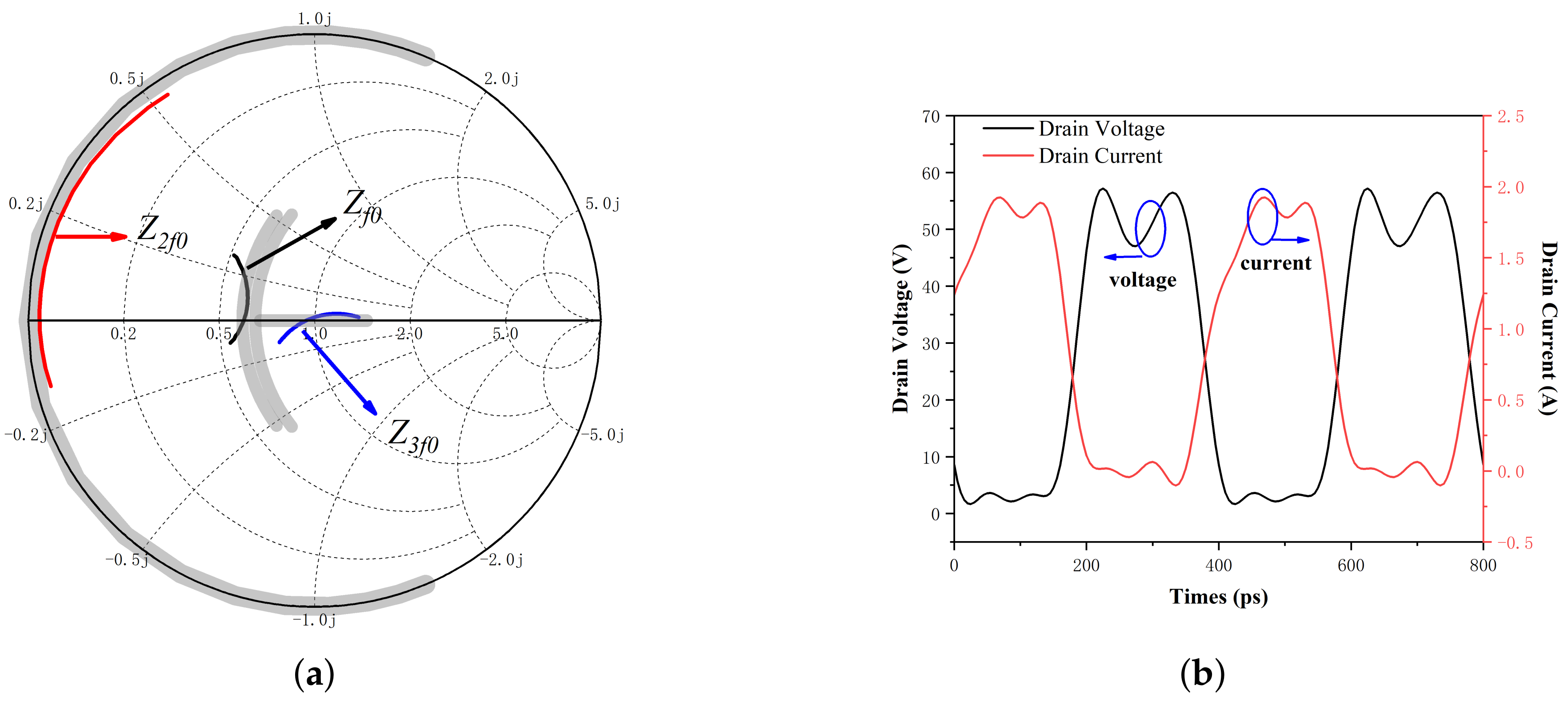
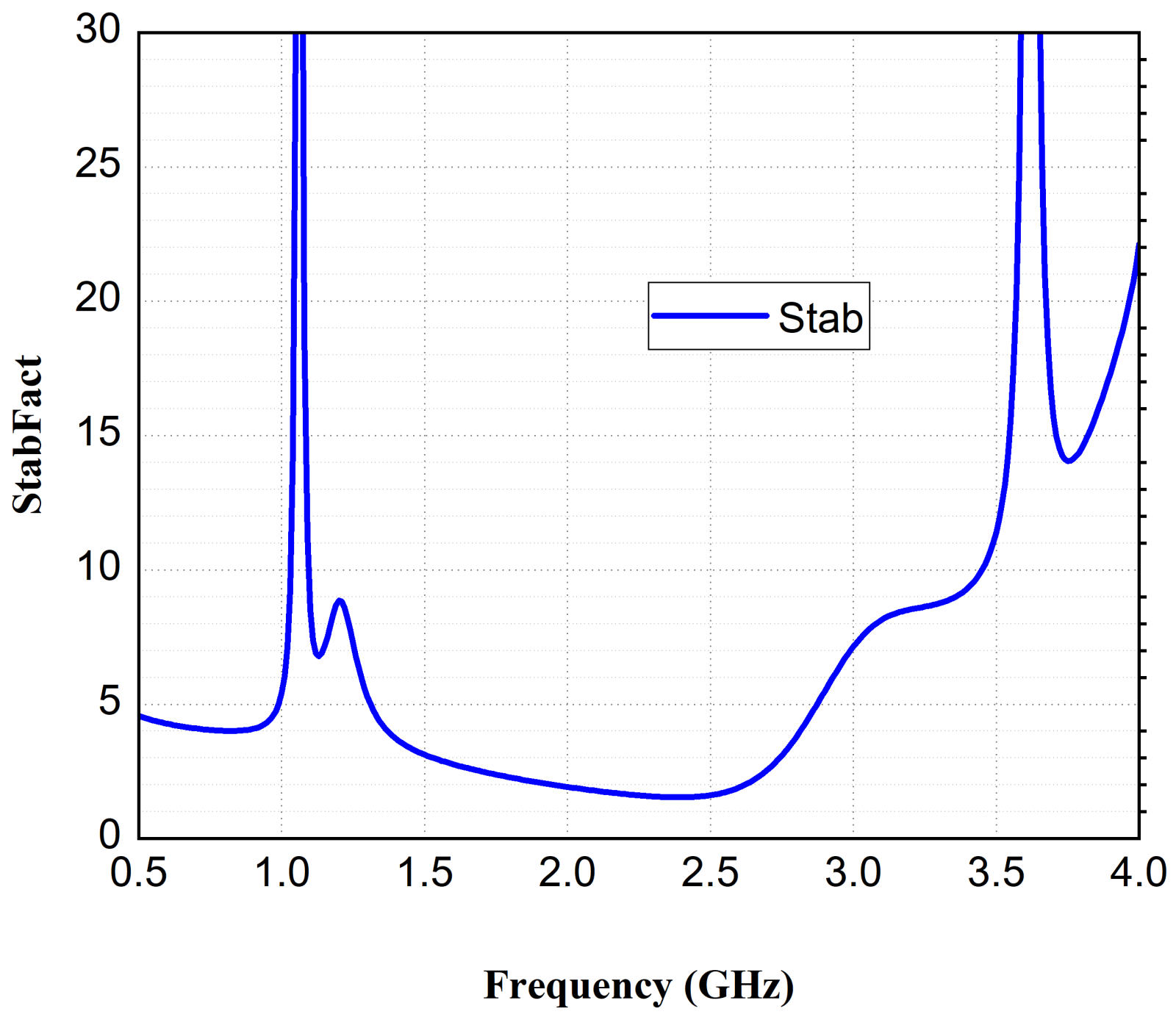
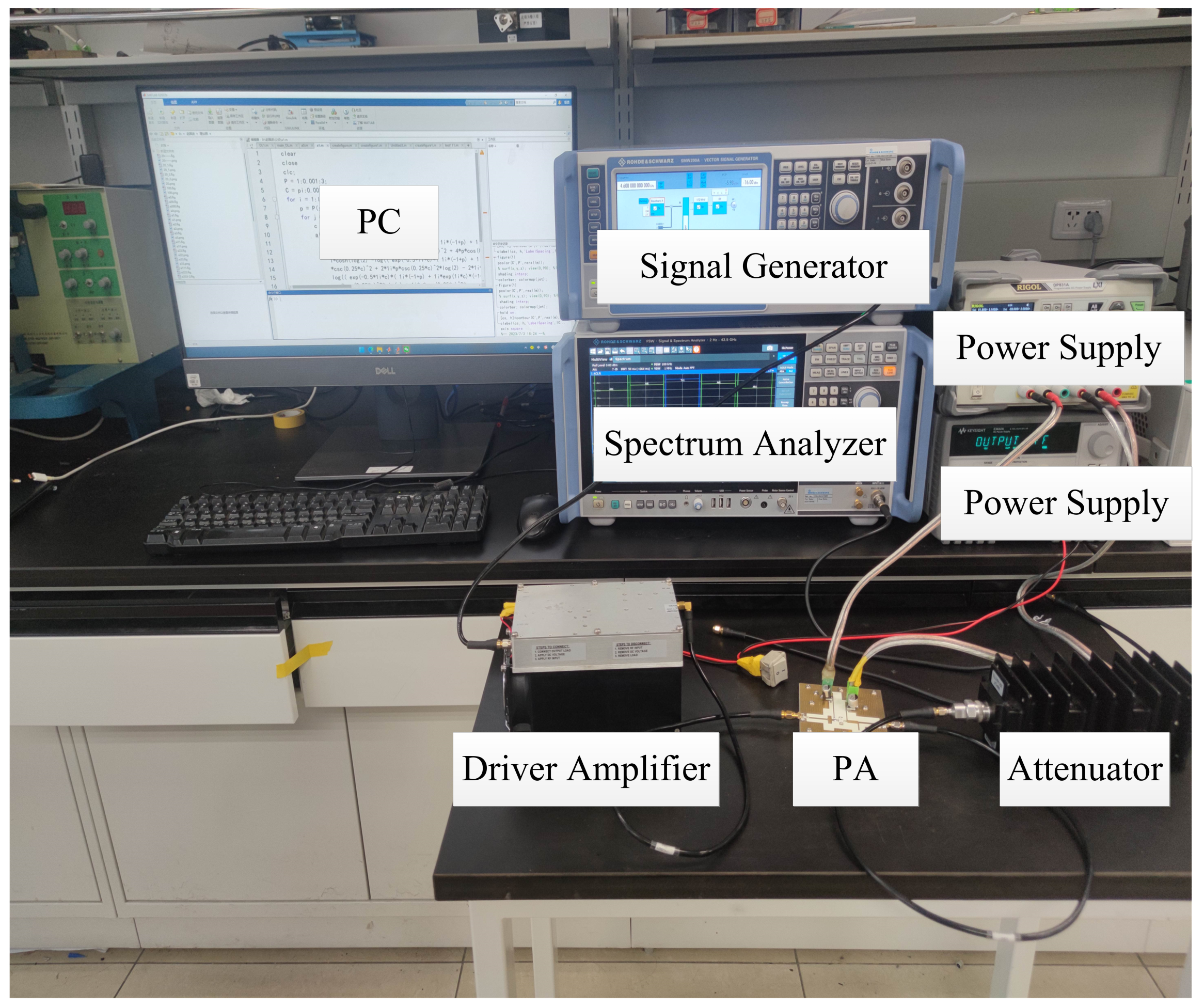



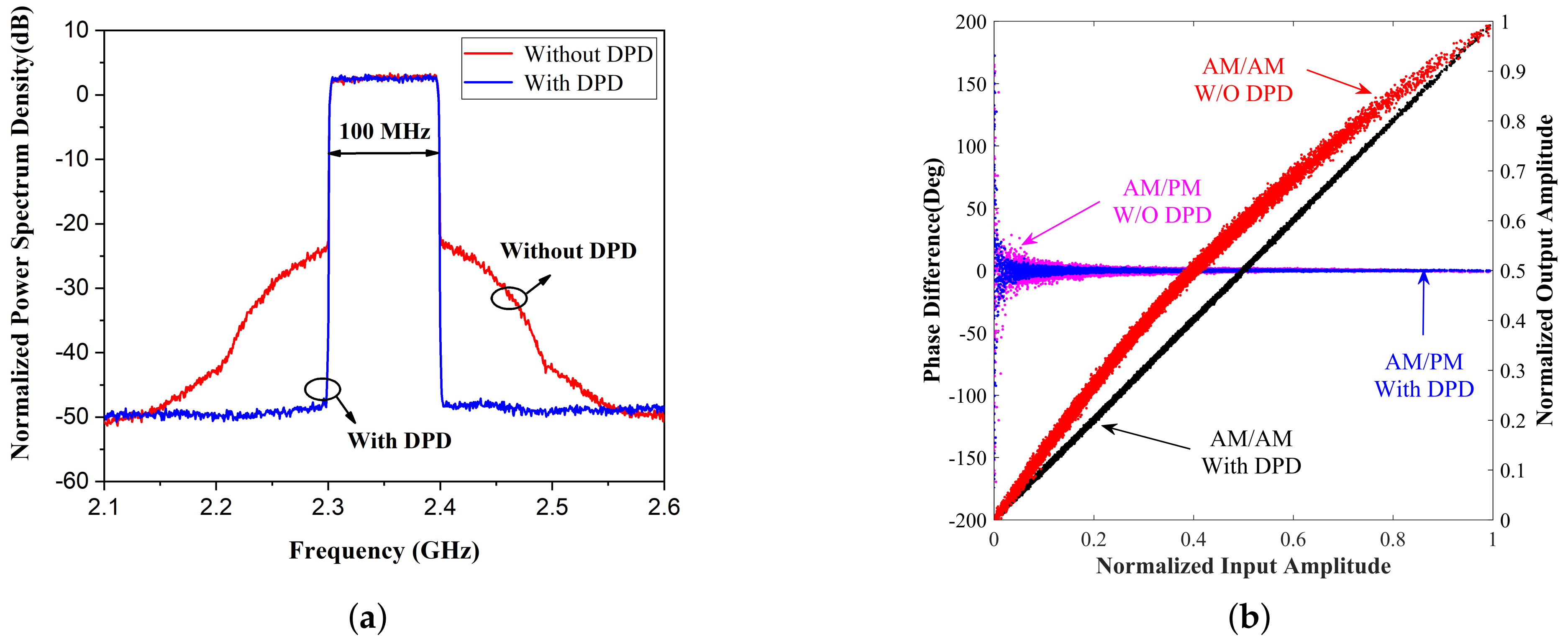
| Refs. | Mode | Freq (GHz) | Pout (dBm) | DE (%) | Transistor | Substrate | Size (cm × cm) | S11 (dB) | S22 (dB) | S21 (dB) | Pave (dBm) | DEave (%) | Signal BW (MHz) | ACPR wo/w DPD (dBc) (PAPR (dB)) |
|---|---|---|---|---|---|---|---|---|---|---|---|---|---|---|
| [23] | CCF | 1.45–2.45 | 40.2–42.2 | 66–74.6 | CGH40010F | Taconic RF35 | N/A | N/A | N/A | N/A | 35 | 46 | 40 | −24.9/−49.7 (N/A) |
| [26] | GCCF | 0.5–0.95 | 38–40 | 73–79 | NXP AFT27S006N | Rogers 4003C | N/A | N/A | N/A | N/A | 33 | 32–41 | 5 | −35/−43 (N/A) |
| [30] | 1.6–1.8 | 41.6–42 | 72–74 | CGH40010F | Rogers 4350B | 5.5 × 7 | N/A | N/A | N/A | 35 | 34 | 20 | −34/−49 (6.5) | |
| [39] | Filtering | 2.0–2.4 | 39–40.4 | 69–78.2 | CG2H40010F | Rogers 4350B | 8 × 6 | −10 | N/A | 13.4–15.1 | N/A | N/A | N/A | N/A |
| [35] | Filtering | 1.85–2.1 | 38.6–39 | 58.5–73 | CGH40010F | RT/Duroid 5880 | N/A | −10 | N/A | 13 | N/A | N/A | 20 | −34.8/−57.8 (7) |
| [36] | BJ | 1.6–2.8 | 40 | 65–66 | CGH40010F | Rogers 4350B | 6.7 × 5.3 | N/A | N/A | N/A | 30.64 | N/A | 5 | −36.5/−55.8 (8.2) |
| [40] | CF | 2.25–2.51 | 40.8 | 51–67 | CGH40010F | Rogers 5880 | 8.1 × 2.9 | −10 | N/A | 17 | N/A | N/A | N/A | N/A |
| [37] | 1.35–2.5 | 41.1–42.5 | 68–82 | CGH40010F | Taconic RF35 | N/A | N/A | N/A | N/A | 34.6 | 37 | 20 | −26.4/−45.2 (7) | |
| [38] | 3.05–3.85 | 39.9–41.4 | 70–78 | CG2H40010F | Dupont 9K7 | N/A | N/A | N/A | N/A | 32 | N/A | 20 | −26/(N/A) (10.45) | |
| [34] | 2.0–2.6 | 40.1–40.8 | 71.2–77.3 | CG2H40010F | Taconic TLY−5 | N/A | N/A | N/A | N/A | 31.8 | 34.21 | 100 | −22.99/−48.76 (8.5) | |
| This work | UCCF | 2.05–2.65 | 40.1–41 | 67.0–73.2 | CGH40010F | Rogers 4350B | 8.8 × 8.6 | −14 | −12 | 14 | 32.4 | 34.39 | 100 | −34.8/−57.8(8) |
Disclaimer/Publisher’s Note: The statements, opinions and data contained in all publications are solely those of the individual author(s) and contributor(s) and not of MDPI and/or the editor(s). MDPI and/or the editor(s) disclaim responsibility for any injury to people or property resulting from any ideas, methods, instructions or products referred to in the content. |
© 2024 by the authors. Licensee MDPI, Basel, Switzerland. This article is an open access article distributed under the terms and conditions of the Creative Commons Attribution (CC BY) license (https://creativecommons.org/licenses/by/4.0/).
Share and Cite
Li, F.; Yu, C. Ultra-Generalized Continuous Class F Power Amplifier with Finite Third-Harmonic Load Impedance. Electronics 2024, 13, 2284. https://doi.org/10.3390/electronics13122284
Li F, Yu C. Ultra-Generalized Continuous Class F Power Amplifier with Finite Third-Harmonic Load Impedance. Electronics. 2024; 13(12):2284. https://doi.org/10.3390/electronics13122284
Chicago/Turabian StyleLi, Feifei, and Cuiping Yu. 2024. "Ultra-Generalized Continuous Class F Power Amplifier with Finite Third-Harmonic Load Impedance" Electronics 13, no. 12: 2284. https://doi.org/10.3390/electronics13122284






